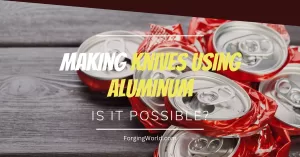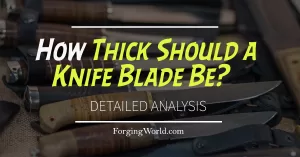When you get into the knife-making world, the questions appear non-stop. This article will discuss the best glue choice for a knife handle and provide you with helpful tips for successful gluing. Since many people argue on this topic, I decided to analyze both views and give you the best possible answer.
Epoxy is generally considered the best glue choice for a knife handle. Epoxy is adhesive and typically comes in two parts, known as a resin and hardener. Mixing these two provides excellent gluing properties for attaching the handle to the blade’s tang.
Next, we will learn more about epoxy and its use in knife making. Finally, I’ll give you some gluing tips so you can do this the best you can.
What Is the Best Epoxy for a Knife Handle?
While there are various measures of the qualities of epoxies, the only thing that matters to a knifemaker is how well it holds in knife-making applications.
With all that said, three options come to my mind:
I have personally tested and used all of them, and I must say that it is very hard to put one aside and say it is the best. However, if I had to, it would be the G/Flex Epoxy. I have been using that one for a long time and could not be happier with it.
The glue line is fine in terms of the Devcon epoxy, but I noticed some tiny gaps on one side under the microscope. However, it may just be that I didn’t apply it perfectly right there at the edge.
When it comes to J-B Weld, I noticed that sometimes it leaves a thicker glue line and is visible on one side. However, it is thinner than I thought it would be, but it will probably always show something if used for handle slabs.
If you want to use super glue, make sure it’s precise glue instead of super glue gel. Otherwise, you will have problems filling gaps.
For example, Gorilla Micro Precise Super Glue is way better for this type of work than Gorilla Super Glue Gel.
You will also need to clamp it much harder than you would epoxy. Usually, the tighter the clamping, the better.
I will discuss more epoxy vs. super glue down below and you can check out this detailed video comparing all the epoxies.
Epoxy Fundamentals for Knifemaking
Epoxy is a synthetic resin that is used for a variety of different purposes, including knife making. Epoxy is made by mixing two matched components, a resin, and a hardener. When these two are mixed, a chemical reaction is set in motion, typically lasting several hours. After mixing a resin with a hardener, the material changes from liquid to solid state.
Regarding the resin-to-hardener ratio, 1:1 is generally recommended, although it may sometimes vary depending on the material. That is why it is extremely important to measure accurately; otherwise, it won’t cure properly. Note that epoxy has different gluing properties, and its application depends on the manufacturer’s specifications.
Factors such as hardness, duration of the curing process, and viscosity play a crucial role in determining which epoxy you need for knife making. Note that epoxy is very sensitive to temperature, so working in a cold shop won’t be the same as working in a warm environment. You may come across terms like pot life and working life in terms of terminology.
Pot life refers to the required time for an initially mixed viscosity to double or quadruple, depending on the viscosity level of the product. Timing starts from the moment of mixing and is measured at room temperature. Another way of defining it is the amount of time mixed epoxy can sit before being usable.
On the other side, working life refers to the amount of time an epoxy stays low in viscosity and can still be used for a certain application. You could also say that working life is the amount of time mixed epoxy can sit in a joint before it stops being usable. Many people think these two are the same, but they aren’t.
As you may already know, the chemical reaction between resin and hardener creates heat which speeds up the curing of the epoxy. So, when the epoxy is sitting in a mixing cup, it will get gummy and unworkable much quicker than when it spreads out.
Also, every knifemaker should understand the cure time of epoxy, which is generally temperature-dependent. Most manufacturers specify 70 degrees for their times, so if your ambient temperature is low, the longer it will take epoxy to cure.
Another fact worth mentioning is that epoxy degrades over time. If you leave epoxy on the shelf for months and months, chances are it won’t cure as hard or quickly as they supposed to.
That was my problem in the beginning. I have often wondered how long it sits there, and when I used it, I realized that I should throw it out. So, if you are not sure how long you had an epoxy, dump it and get a new one.
Some epoxies cure very hard, but these tend to be also brittle. Again, different formulations will vary. My recommendation is to check your manufacturer’s datasheet. Just because the epoxy is rated by particular strength doesn’t mean it will be strong in all applications. Moreover, hardness increases shear strength, whereas flexibility increases shock resistance and peel strength.
One of the most important things you have to understand is that surface preparation is the key to success whatever epoxy you may use.
For a beginner knifemaker, starting to work with epoxy may seem a little expensive but trust me, using cheap glue for a knife handle is even more expensive as it can ruin your hard work. Note that some epoxies can contain chemicals that are hazardous to health. If your material doesn’t cure completely or it is difficult to mix, these solvents can evaporate.
Epoxy vs Super Glue for Knifemaking
Both are popular names for various products covering a broad range of adhesives. Each has its specific chemical composition and recommended use. While they have some common applications, they are most effective when used for their specific purpose.
The greatest difference is that epoxy is made from two components (a resin and a hardener). At the same time, superglue is composed of only one component, cyanoacrylate, which hardens quickly with exposure to moisture.
While both form a strong bond, epoxy is considered a superior option in knife making. Epoxy has greater shear strength and structural strength. It fills voids between parts amazingly well. All that makes it ideal for attaching the handle to the blade.
Epoxy is best removed with white vinegar or acetone before it hardens to clean it up. Otherwise, it is extremely difficult to remove without damaging the knife handle. On the other side, you can remove Super Glue in both liquid and solid-state with acetone or gamma-butyrolactone.
Note that you should use both in well-ventilated workshops. For better safety, wearing rubber gloves and eye protection during work with these chemicals is recommended.
Epoxy Gluing Tips
Finally, I want to give you some tips about epoxy gluing. After all, it is much better to learn from other people’s mistakes. So, here are several tips to keep in mind when working with epoxy:
- The number one and also the most important advice is to you have to properly clean the surface before you use any glue, not just epoxy. You can do that with acetone or soap and water.
- After you cleaned the surface, DO NOT TOUCH IT.
- Scuff up the surface that you will be epoxying. This increases the surface area and also gives more 3D area for the epoxy to cling to.
- Glue as quickly as possible after you prepared the surface. The more you wait, the more surface is likely to pick up dust or oxidize.
- Always follow the manufacturer’s recommendation about mix ratios between a resin and hardener
- Don’t clamp it too hard as you can squeeze epoxy out of a joint


